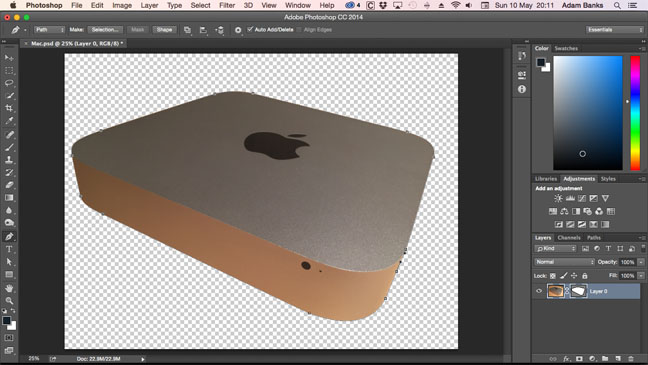This article is more than 1 year old
It’s Adobe’s Creative Cloud TITSUP birthday. Ease the pain with its RGB-wrangling rivals
Alternatives to pixel-poking behemoth Photoshop
Missing in action?
Photoshop Elements 13, Adobe’s consumer option, is a standalone Mac and Windows product costing £64.81. It’s very good, but more for preset effects and homework projects than serious image manipulation.
The same shortcomings apply to many rival apps. In fact, when you look for true editing capabilities rather than just basic adjustments and filters, there are fewer contenders than you might think. Among the Photoshop features typically missing or inadequate elsewhere are:
• Selection tools – cut out parts of images seamlessly. The devil’s in the detail here: beyond the basic Lasso and Magic Wand, you need smart edge selection aids that actually work, plus facilities to refine further
• Paths – vector drawing is part of the retoucher’s toolkit, and images with crisp ‘clipping paths’, rather than soft anti-aliased edges, are still a staple of print publishing
• Layers and masks – build up a finished picture from independently editable overlays. Crucially, ‘adjustment layers’ add corrections that can be edited later
• Distortion – autocorrect photos shot with lens distortion or off-centre, or distort objects to combine them seamlessly with others
• Sharpening – with controllable methods like Unsharp Mask, not just one slider
• Tone curves – histogram displays with editable Levels and Curves, plus additional options such as colour balance editing
• Highlights and shadows – restore detail by selectively adjusting contrast in the darkest and lightest areas, a relatively new technique that can rescue difficult exposures
• Cloning, healing and content-based fill – essentially, repeat parts of a photo to cover unwanted elements. The basic ‘clone stamp’ tool is almost universal, but cleverer additions vary

When you want a crisp cutout, a vector mask is the answer, and these can be stored as ‘clipping paths’ in image files for import into desktop publishing apps – but Photoshop is almost unique in fully supporting this – click for a larger image
Not all image editing apps are Photoshop wannabes. On the Mac, there’s a trend for lightweight web-oriented graphics programs refined down to the features your Shoreditch hipster requires. They’re refreshingly neat, but may leave too much out.
On the PC, the likes of Corel and Serif offer closer rivals to Adobe at lower prices. And no money at all buys the venerable open-source GIMP (GNU Image Manipulation Program), popular with Linux users and also available for Windows and Mac. Chromebook owners can take advantage of browser-based options such as Pixlr.
The first question photographers will ask of an app is ‘Does it support raw?’ Raw image files capture the data direct from the camera’s sensor rather than pre-converting it to a format such as JPEG, leaving a lot more latitude to adjust exposure, colour balance and so on.
If you’re working with images straight from a decent camera then yes, you do need raw processing – which some image editors don’t support, or support badly. You could use the raw utility supplied by your camera maker for initial processing instead, but that’s an extra step to waste time on.
Most non-raw images are stored with 8 bits per channel (RGB) for 24-bit colour (16.7 million colours). That’s plenty for human vision, but there’s an argument for using more bits per channel when editing, to avoid losing detail to clipping. More image editors these days support 16 bits per channel.
Photoshop’s 32-bit mode also enables the creation of high dynamic range (HDR) images – not to be confused with mere HDR effects, which try to force extra detail out of standard pics. Using HDR, you can combine multiple exposures into one perfected shot. Other image editors don’t offer this.
Install almost any modern graphics app under any modern OS and you should get basic colour management, so what you see on screen is reasonably “correct”. Most apps also let you apply a colour profile supplied by your printer manufacturer (or commercial press) to “soft proof” how final output will look. Photoshop offers more detailed colour management options, but most users won’t need them.
In the past, CMYK sorted the photo-editing wheat from the chaff. Print pros like me had to convert images to this subtractive colour format, from additive RGB, before they could be used in desktop publishing software.
Today, even those of us who still work in print rarely convert to CMYK in Photoshop because modern DTP workflows are RGB – everything gets converted to CMYK only on final export from InDesign or QuarkXPress.
The ability to save an image in CMYK TIF format is only really useful if you’ve edited it in CMYK mode, setting colours to the exact ink values you want. Most image editors support CMYK output but not CMYK editing, which is pointless – and another reason to stick with Photoshop.
